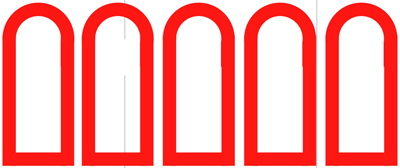 Three things happen in a marketplace. One is transaction, another is conversation and the third is relationship. Let’s talk about what you, as a customer (not just a consumer), can do with each.
Three things happen in a marketplace. One is transaction, another is conversation and the third is relationship. Let’s talk about what you, as a customer (not just a consumer), can do with each.
Transaction
Let’s start with price. Here in the industrialized world, price has been something that sellers have set, and buyers have paid, ever since John Wanamaker invented the price tag in the late 1800s. In some cases buyers have had room to haggle (such as with buying a horse or a car), but on the whole we customers pay what sellers ask. Or we move on.
A price is a signal. So is buying something. So, in a less direct way, is not buying. But those aren’t the only signals that matter. A lot can happen between the point where you start shopping and any seller’s bottom line, on both the seller’s part and yours.
Take the signaling system called advertising, which is becoming a half $trillion business, worldwide. Most advertising is, almost by definition, wasted. Wanamaker’s famous quote — “Half my advertising is wasted. I just don’t know which half. — was off by nearly fifty percent. The amount of advertising that does nothing for customers is usually close to one hundred percent. Sure, advertisers try to minimize waste; and in many cases (such as Google’s AdSense and AdWords), advertisers only pay for clicks. And advertising pays for many good things in the world. But there is a limit to what it can do for you, as an individual buyer, and that limit is set by who does the signaling.
What if you were able to signal your interest in an umbrealla, some binoculars, size 9EEEE running shoes, or a stroller for twins, in the next half hour — and to do that in a secure way that doesn’t reveal to potential sellers any more than they require to respond, and doesn’t put you into any marketer’s pitch mill? What if you could name the price you’d pay for whatever — and not have to do that inside any company’s closed and private marketplace?
Conversation
The first thesis of The Cluetrain Manifesto is “Markets are conversations.” We meant several things by that. One, as we explained in the book, was
The first markets were markets. Not bulls, bears, or invisible hands. Not battlefields, targets, or arenas. Not demographics, eyeballs, or seats. Most of all, not consumers.
Another was this:
For thousands of years, we knew exactly what markets were: conversations between people who sought out others who shared the same interests. Buyers had as much to say as sellers. They spoke directly to each other without the filter of media, the artifice of positioning statements, the arrogance of advertising, or the shading of public relations.
These were the kinds of conversations people have been having since they started to talk. Social. Based on intersecting interests. Open to many resolutions. Essentially unpredictable. Spoken from the center of the self. “Markets were conversations” doesn’t mean “markets were noisy.” It means markets were places where people met to see and talk about each other’s work.
Conversation is a profound act of humanity. So once were markets.
Marketing got the message, and conversation of the literal sort is now part of the marketing canon. But marketing reform didn’t stop there. Marketing is now all gaga over “social media” as well, in part because many believe that Cluetrain was all about “social” markets. I don’t remember thinking about it that way at the time, but I can see why people think so. Regardless of that, there is a big delta between social activity in markets and “social media” as they are understood today. Here are the first two paragraphs of Wikipedia’s social media entry (since it will be revised, here is the version I’m quoting:
Social media are media for social interaction, using highly accessible and scalable publishing techniques. Social media use web-based technologies to transform and broadcast media monologues into social media dialogues. They support the democratization of knowledge and information and transform people from content consumers to content producers. Andreas Kaplan and Michael Haenlein define social media as “a group of Internet-based applications that build on the ideological and technological foundations of Web 2.0, and that allow the creation and exchange of user-generated content.”[1] Businesses also refer to social media as user-generated content (UGC) or consumer-generated media (CGM). Social media utilization is believed to be a driving force in defining the current period as the Attention Age. A common thread running through all definitions of social media is a blending of technology and social interaction for the co-creation of value.
Social media have been modernized to reach consumers through the internet. Social media have become appealing to big and small businesses. Credible brands are utilizing social media to reach customers and to build or maintain reputation. As social media continue to grow, the ability to reach more consumers globally has also increased. Twitter, for example, has expanded its global reach to Japan, Indonesia, and Mexico, among others. This means that brands are now able to advertise in multiple languages and therefore reach a broader range of consumers. Social media have become the new “tool” for effective business marketing and sales.[2] Popular networking sites including Myspace, Facebook and Twitter are social media most commonly used for socialization and connecting friends, relatives, and employees.
Wisely, Wikipedia has the entry flagged for “multiple issues.” Here are mine:
- The “social media” named above are corporate entities, not personal ones. Blogging, instant messaging, texting, emailing, voice and other equally (or more) social and conversational technologies — ones that are not owned by anybody, most of which rely on the Net’s agnostic protocols — are ignored.
- “Social media” is for marketing. In other words, something that exists mostly to serve sellers, not buyers.
Forgotten or ignored by the writers, and by marketing in general, is Cluetrain’s prime clue: one that comes before all ninety-five theses:

Social media, as described by that Wikipedia entry, are about extending marketers’ grasp. Not about extending the reach of human beings.
The Cluetrain hasn’t jumped the tracks here. But a lot of marketers sure have.
Relationships
Companies care about relationships with customers, of course. They manage those relationships many ways, including customer relationship managment (CRM) systems. While not nearly as big as advertising, CRM is still a huge industry. In “CRM: Then and Now”, Josh Weinberger of CRM Magazine writes,
According to figures from AMR Research (now part of industry-analysis giant Gartner), annual sales of CRM software exploded from $762 million in 1997 to $14 billion in 2007—nearly a 20-fold increase in just a decade.
Over on your side — the customer side — we have VRM, for Vendor Relationship Management. Thanks to Josh and other good folks at CRM Magazine, VRM is on the CRM radar. (Here’s the table of contents for the May edition of the magazine, with a series of VRM — and Cluetrain — related articles. And here’s what I wrote about those on the ProjectVRM blog.) Right now VRM is a $0 billion business. But then, so was the Internet at one point. (At a base level, it still is, even though it supports $trillions in business activity.) So, while VRM is still pre-natal, the Internet isn’t much older. If we date the commercial Web from the start of e-commerce in 1995, it’s a sophomore in high school. If the slate of economics in the Internet Age has a near-infinite height and width, most of it is still clean.
The informational environment supported by the Internet’s growing protocol suite is already much larger and more thick with possibilities than could ever be contemplated in the old brick-and-mortar retail world. This new environment also encompasses and enlarges the scope of brick-and-mortar business far beyond their old physical dimensions. The Net also invites the development of tools for doing just about anything that can be imagined when every connected entity is at a functional distance of zero from every other entity. That’s why the Net’s protocol suite has grown over the years, and will continue to grow. It seems only reasonable that some new tools coming down the pike will help buyers manage relationships with sellers at least as well as sellers manage relationships with buyers.
Right now there are many tools, services and other stuff in the VRM pipeline. In the next two posts I’m giong to show you a couple of those tools. The first is ListenLog, which provides a way for online listeners to log their own activities, and to better understand which stations ane programs matter to them, and how. The second is EmanciPay, which does two things. One is provide a way for customers to signal the amounts they are willing to pay, and for what. The other is to signal the customer’s own terms of engagement, as an alternative to the current seller-provided terms, which by default —
- are based on distrust,
- almost nobody reads,
- give all advantages to the seller,
- have hardly changed since 1995, and
- don’t exist in the everyday brick-and-mortar world, where you don’t have to become a “member “of a store just to buy a shirt or shoes there.
Borrowing the argot of economics, we’re looking here to reduce or eliminate information asymmetry, and to apply the Internet’s end-to-end principle to buyer-seller interactions. Our goal is not to create a whole new kind of marketplace, but rather to return the ones we have to what markets were like before industry won the Industrial Revolution: places where buyers and sellers met, talked, came to know one another — and otherwise engaged in a system that was not limited to choices provided only by sellers.
It helps consider the matter of context. That is, your context. Right now, as a customer, your context is usually comprised of many retailers, each with many products. The way the industrial retailing system works today, most sellers want to control their relationship with you, inside their CRM system, or whatever other systems they use. In the tech world, we call each of these a silo. The mental model looks like the image on the left.
your context is usually comprised of many retailers, each with many products. The way the industrial retailing system works today, most sellers want to control their relationship with you, inside their CRM system, or whatever other systems they use. In the tech world, we call each of these a silo. The mental model looks like the image on the left.
Retail silos are controlled and contained spaces, each standing on the seller’s own foundation: its rules for interacting with customers. All the seller’s goods are in there. So are its employees, its legal stuff, its products, its R&D, its trade secrets — and its data about you.  That data includes whatever you’ve shared with them, knowingly or nor not, in the course of doing business with them, or simply moving about in the world, leaving a crumb-trail of information about yourself and what you’ve done. In many cases your relationship is formalized with a “loyalty card” (like the ones on the right) or some other form of membership.
That data includes whatever you’ve shared with them, knowingly or nor not, in the course of doing business with them, or simply moving about in the world, leaving a crumb-trail of information about yourself and what you’ve done. In many cases your relationship is formalized with a “loyalty card” (like the ones on the right) or some other form of membership.
Each of these is your membership in a seller’s silo. Thus the pile of cards shown on the right can also be represented this way:

Your relationships in this environment are all separate, requiring that you operate within each retailer’s container. Your personal data, preferences and buying history with one company are not easy to move or duplicate into another. Nor are they meant to be. The way this system works, the sellers make all the rules. And each seller has its own rules. By this system, a free market is your choice of silo.
You too have a container as well. That container is what you consider private and yours alone, even if some of it is shared, selectively, with other parties. This information might include your relationships, your finances, your weight, your diet, your travels, your health. True, much of that data (for example, with health) is out of your hands. But you still have a sense of what’s private and yours alone.
For a look at how much your own silo matters, do a search for “privacy“. The one I just did brought up 1,390,000,000 results. That’s more than the results for “face” and “hand” put together. Privacy is a big deal in these early Internet years because you’re not in control of it. All those silos out there — the ones with your personal data — have far more control over your data than you do.
Markets, in both their literal and metaphorical meanings, are middle grounds. They are places where we are selectively open to society, and especially to sellers — and where they are open to us. One way to represent that is to turn our silos on their sides and open them up, so we each have a representation of containment, but also of openness, and even of attraction. So, instead of having silos, we have magnets, like this:
You are on the left. The seller is on the right. And the market is in the middle.
The VRM community is working on building this out. (As we said above, the CRM community has begun to join the effort as well.) We are doing this by creating ways of relating in which both sides are open to the other, but neither contains the other. The two can have attractions toward each other, but engagement is optional. Think of the result as a market that’s far more free than the your-choice-of-silo model.
We call these two shapes “r-buttons“. The “r” is for relationship. We use the color red, at least some of the time, because that was the color I used when I first drew r-buttons on a whiteboard when I was describing to PRX techies how VRM worked. At the time I was just talking about buyers and sellers, not designing graphic representations of anything. But the casual illustration worked, so we’ve run with it. (My wife just suggested that the two buttons together might be “our-buttons”. I like that.)
Next: ListenLog.
After that: EmanciPay.

Leave a Reply